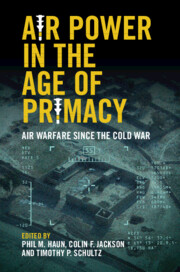Book contents
- Air Power in the Age of Primacy
- Air Power in the Age of Primacy
- Copyright page
- Contents
- Figures
- Tables
- Contributors
- Preface
- Abbreviations
- 1 Air Power in the Age of Primacy
- 2 Remote Warfare: A New Architecture of Air Power
- 3 Deliberate Force: Ambivalent Success
- 4 Hoping for Victory: Coercive Air Power and NATO’s Strategy in Kosovo
- 5 Operation Enduring Freedom
- 6 The Result Is Never Final: Operation Iraqi Freedom
- 7 Israeli Air Force Effectiveness during the Second Lebanon War (2006)
- 8 Libya 2011: Hollow Victory in Low-Cost Air War
- 9 Coercing a Chaos State: The Saudi-Led Air War in Yemen
- 10 Russia’s Air War Win in Syria
- 11 Air Power in the Battle of Mosul
- 12 Retrospect and Prospect: Air Power in the Age of Primacy and Beyond
- Index
6 - The Result Is Never Final: Operation Iraqi Freedom
The Greater Thirty Years War, 1990–
Published online by Cambridge University Press: 16 December 2021
- Air Power in the Age of Primacy
- Air Power in the Age of Primacy
- Copyright page
- Contents
- Figures
- Tables
- Contributors
- Preface
- Abbreviations
- 1 Air Power in the Age of Primacy
- 2 Remote Warfare: A New Architecture of Air Power
- 3 Deliberate Force: Ambivalent Success
- 4 Hoping for Victory: Coercive Air Power and NATO’s Strategy in Kosovo
- 5 Operation Enduring Freedom
- 6 The Result Is Never Final: Operation Iraqi Freedom
- 7 Israeli Air Force Effectiveness during the Second Lebanon War (2006)
- 8 Libya 2011: Hollow Victory in Low-Cost Air War
- 9 Coercing a Chaos State: The Saudi-Led Air War in Yemen
- 10 Russia’s Air War Win in Syria
- 11 Air Power in the Battle of Mosul
- 12 Retrospect and Prospect: Air Power in the Age of Primacy and Beyond
- Index
Summary
For more than thirty years, a conventional mindset of applying force has clashed with the passions of the Iraqi people, complicating decisive outcomes despite US-led coalitions possessing overwhelming technological superiority in Iraq. Most studies of Operation Iraqi Freedom focus almost exclusively on the first few weeks of largely conventional
force employment, thereby missing how much this campaign has in common with other contemporary air campaigns. Air power made enormous contributions against the military “leg” of the Clausewitzian triangle over the course of thirty years with precision and stealth capabilities, but this advantage does not translate neatly into enduring strategic effect. As such, OIF should be reevaluated in a balanced manner that focuses more on the complex interactions between militaries, governments, and people and less on the overwhelming application of US kinetic force.
Keywords
- Type
- Chapter
- Information
- Air Power in the Age of PrimacyAir Warfare since the Cold War, pp. 121 - 147Publisher: Cambridge University PressPrint publication year: 2021
- 1
- Cited by

